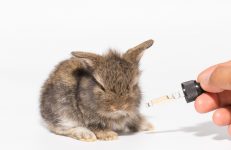NZ Bans Animal Testing for Cosmetics

Animal testing has been instrumental in the the development of new medicines that are important to saving human lives and making our daily existence a little easier and more comfortable.
But there is a moral cost – millions of animals have been put through torturous procedures for our benefit, and there will be many more to come. Many animals are being tortured as we speak.
NZ bans animal testing for cosmetics
New Zealand is now leading the way in the Asia-Pacific region when it comes to reducing the suffering of animals through testing.
Our eastern neighbour recently made headlines when it passed a new law banning the testing of ingredients and finished products on animals.
Testing cosmetics may remind us of memes depicting fluffy bunnies having their fur shampooed or chimpanzees wearing make-up – but the reality is very different, and the practice can certainly amount to animal cruelty.
Countless mice, rats and rabbits have been forced to endure painful and distressing tests each year. Rabbits are often used because they have skin that is more sensitive than humans, so shaving products are rubbed onto their skin, or even dropped into their eyes in order to test for irritant levels.
For most of us, this kind of cruelty in the name of beauty is unacceptable. New Zealand has now joined several other nations around the world which have already banned the use of animal testing for cosmetics.
Other countries with a ban in place
The EU, Israel and India have already banned animal testing for cosmetic products. It has been illegal in the United Kingdom since 1997.
China previously made it compulsory for cosmetics sold in that country to be tested on animals. For many cruelty-free international manufacturers, this created a dilemma between compromising their values by testing their products on animals on the one hand, and passing up the opportunity to enter the lucrative Chinese market on the other.
But last year, China removed mandatory animal testing requirements for some cosmetics.
What does the NZ law cover?
The New Zealand law bans all animal testing of both ingredients and finished products for the cosmetics industry.
The Minister for Primary Industries, Nathan Guy, says that to the best of his knowledge, no cosmetic products were being tested on animals in New Zealand even before the ban. He believes that the move nevertheless sends a strong message that animal testing for cosmetics will not be tolerated in New Zealand.
NZ Greens MP Mojo Mathers tabled the original Bill in parliament last year, but her proposal was deemed too broad because it also covered pharmaceutical products. She is nevertheless “over the moon” that the new law has finally been passed.
But although the law is a step in the right direction, the fact remains that 90% of beauty products stocked in NZ shops are made overseas. Those products may have been tested on animals, and activist groups are currently lobbying for a ban on the sale of all cosmetic products tested on animals.
What is the current law in Australia?
It is reported that Australian-made cosmetics are not tested on animals, but there is currently no law against it.
Last year, Senator Lee Rihannon introduced a Bill called the End Cruel Cosmetics Bill. The proposal cited a survey from 2013 which found that 81% of Australians did not want cosmetic products being tested on animals.
It proposed to make it unlawful to “test a substance on a live animal in Australia for the purposes of developing, manufacturing, selling or importing into Australia a cosmetic, or a substance for use in cosmetics.”
Unfortunately, the Bill was rejected by parliament despite the fact that government MPs received more than 15,000 submissions supporting it.
Are there alternatives to animal testing?
No one wants to purchase products that haven’t been properly tested.
But alternative testing methods have emerged in recent years, including the use of reconstituted human skin instead of live animals.
Human skin grown in labs is now an expanding business, and one which may remove the need to test on living animals.
L’Oreal is one company that uses the method, having trialled it on over 13,000 products.
The lab-grown skin is commercially known as Episkin, and was originally a waste product from plastic surgery. L’Oreal says that it the product is a remarkably useful alternative to testing on live animals.
What about animal testing for medicine?
While most of us agree that the suffering of animals should not be tolerated for the sake of beauty, the issue becomes more complex and contentious when it comes to saving or significantly improving human life.
Many of the medicines that we take for granted today have been extensively tested on animals; indeed, many humans would have lost their lives if such testing had not taken place.
Section 24(e)(i) of the Prevention of Cruelty to Animals Act provides a defence to charges of animal cruelty where it was committed ‘in the course of, and for the purpose of carrying out animal research’.
Section 3 of the Animal Research Act defined animal research as:
‘any procedure, test, experiment, inquiry, investigation or study in connection with which an animal is used and, without limiting the generality of the foregoing, includes any procedure, test, experiment, inquiry, investigation or study in the course of which an animal is subjected to:
- surgical, medical, psychological, biological, chemical or physical treatment,
- abnormal conditions of heat, cold, light, dark, confinement, noise, isolation or overcrowding,
- abnormal dietary conditions, or
- electric shock or radiation treatment, or
- any material or substance is extracted or derived from the body of an animal’
This means that it is perfectly legal to subject animals to torture in the name of science or medicine, provided that the administrative requirements of the Act are met.
Incidentally, the Act also provides a defence to animal cruelty charges where it was committed:
‘in the course of, and for the purpose of hunting, shooting, snaring, trapping, catching or capturing the animal, or destroying the animal, or preparing the animal for destruction, for the purpose of producing food for human consumption’.
There are, however, a few exceptions – section 12 of the Prevention of Cruelty to Animals Act says that a person other than a vet shall not:
- dock the tail of a horse, bull, ox, bullock, steer, cow, heifer, calf or dog,
- crop the ears of a dog,
- operate upon a dog for the purpose of preventing the dog from being able to bark,
- remove one or more of the claws of a cat,
- grind, trim or clip one or more teeth of a sheep,
- perform a clitoridectomy on a greyhound, or
- fire or hot iron brand the face of an animal.
Clearly those exceptions are very limited, and perhaps it is time that we better protect our fellow animals against torture by defining ‘animal research’ more narrowly and formulating a broader definition or more comprehensive list of prohibited acts.






